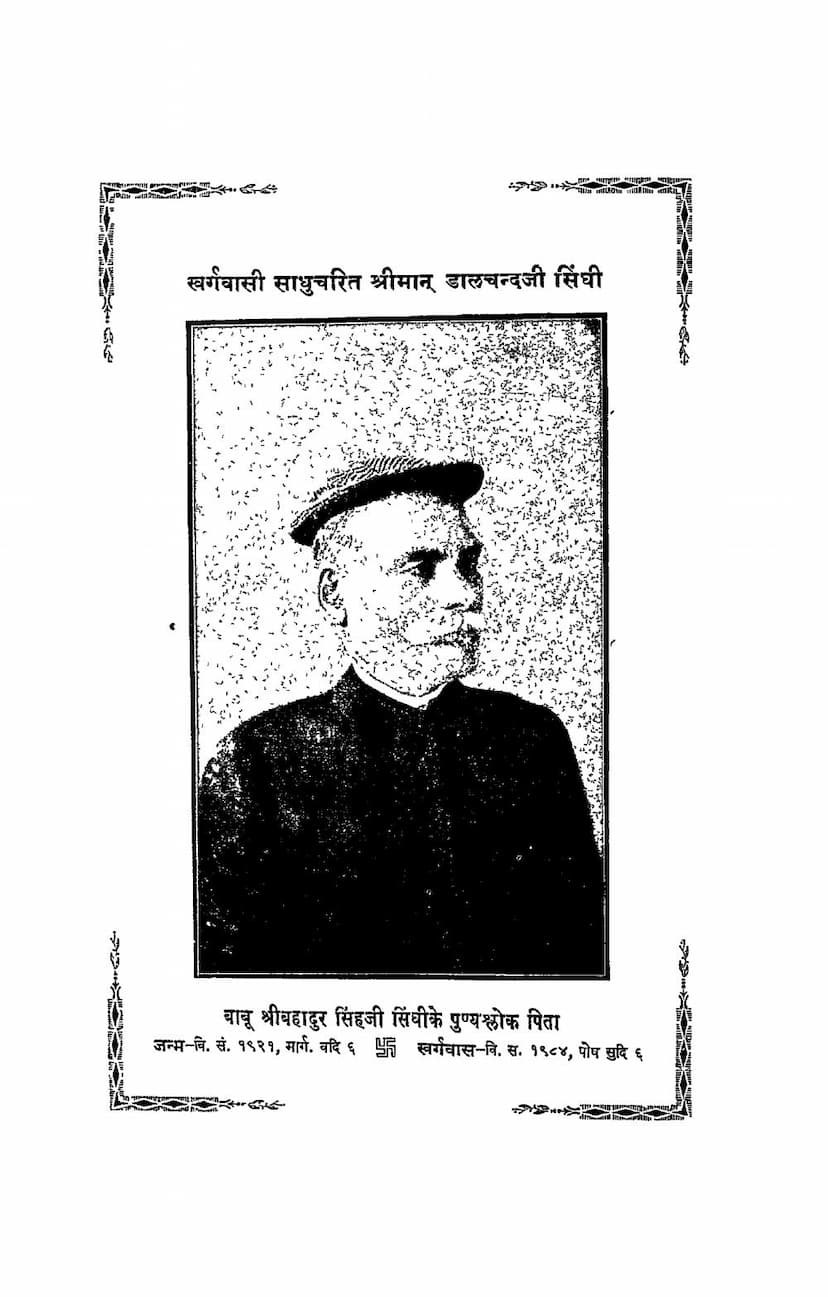Dharmabhyudaya Mahakavya
Added to library: September 1, 2025

Summary
The provided Jain text is the Dharmabhyudaya Mahakavya, also known as Sanghapaticharita, authored by Shri Udayaprabha Suri. Published by Bharatiya Vidya Bhavan as part of the Singhi Jain Series, this epic poem in Sanskrit recounts significant events and characters from Jain history and philosophy.
Here's a comprehensive summary based on the provided pages:
Overall Context and Publication:
- The book is a significant Jain text, published by Bharatiya Vidya Bhavan, Mumbai, as part of the "Singhi Jain Series" (Number 4).
- The publication is a memorial tribute to the late Babu Shri Dalchandji Singhi and was established and published in his memory through the efforts of his son, Babu Shri Bahadur Singhji Singhi.
- The series aims to publish Jain texts of various subjects including Agamic, philosophical, literary, historical, scientific, and narrative, in languages like Prakrit, Sanskrit, Apabhramsha, and ancient Gurjar-Rajasthani.
- Acharya Jinvijay Muni served as the chief editor and director, with the support of the Singhi family.
- The first edition was published in Vikram Samvat 2005 (1949 AD).
Author and Editors:
- Author: Shri Udayaprabha Suri, from the Nagendra Gachchha.
- Editors: Divangat Muni Matallik Shri Chaturvijayji and his senior disciple, the distinguished Jain scholar Muni Shree Punyavijayji.
Content and Themes:
The Dharmabhyudaya Mahakavya is an epic poem that focuses on several key aspects:
- The Life and Deeds of Udayaprabha Suri: Several introductory sections and appendices provide extensive biographical details about Acharya Jinvijay Muni, highlighting his intellectual contributions, his association with influential figures like Rabindranath Tagore, and his role in establishing the Singhi Jain Knowledge Center. These sections also detail the philanthropic efforts of the Singhi family, particularly Babu Dalchandji and Babu Bahadur Singhji Singhi, in promoting Jain literature and education.
- The Glorious History of the Singhi Family: The text emphasizes the dedication of the Singhi family to the preservation and dissemination of Jain knowledge. It details the philanthropic activities and profound respect for Jain literature and culture of Babu Dalchandji Singhi and his son Babu Bahadur Singhji Singhi, who established the "Singhi Jain Granthamala."
- Mahamatya Vastupala: The epic extensively praises Mahamatya Vastupala, a historically significant figure known for his valor, wisdom, generosity, and patronage of Jainism, literature, and art. The text elaborates on his multifaceted personality as a statesman, scholar, poet, and devout Jain.
- Sermons and Teachings: The poem is framed around the teachings and sermons of Jain Tirthankaras and learned monks, particularly Udayaprabha Suri, who guided Vastupala on the path of righteousness and spiritual upliftment.
- Tirthayatra (Pilgrimage): A significant portion of the Mahakavya describes the detailed rituals and procedures associated with Tirthayatra, particularly Vastupala's grand pilgrimages to sacred Jain sites like Shatrunjaya and Girnar.
- Mythological Narratives: The Mahakavya also incorporates numerous mythological stories and tales of past lives (purva-bhava) of Tirthankaras and other important figures, illustrating Jain principles and virtues.
- The Importance of Righteous Conduct: The text underscores the significance of dharma (righteousness), dana (charity), sheela (virtue), tapas (austerity), and bhakti (devotion) as paths to spiritual liberation.
- Historical and Cultural Significance: The Mahakavya serves as a valuable historical document, shedding light on the socio-political and religious landscape of Gujarat during the time of Vastupala and the Chalukya dynasty. It also highlights the patronage of arts and architecture, evidenced by the magnificent Jain temples built during that era. The text draws parallels between historical figures and their virtues, linking them to Jain ideals.
- Detailed Table of Contents: The Vishyānukram (Table of Contents) provides a chapter-by-chapter breakdown of the Mahakavya, outlining the subjects covered in each of its 15 Sargas. These include:
- Chapter 1: Rituals of Tirthayatra, Magnanimity of the Sangh, Magnanimity of Vastupala, Origin of Shatrunjaya, etc.
- Chapter 2: Past lives of Rishabhanatha.
- Chapter 3: Birth and Vows of Rishabhanatha, stories of virtuous individuals.
- Chapter 4: Lives of Bharat and Bahubali.
- Chapter 5: Origin of Shatrunjaya, Nirvana of Rishabhanatha.
- Chapter 6: Nirvana of Bharat.
- Chapter 7: Magnanimity of Shatrunjaya, stories of its benefactors.
- Chapter 8: Life of Jambu Swami, including numerous exemplary tales.
- Chapter 9: The power of penance, life of Yugavahu.
- Chapter 10: Past lives of Neminatha.
- Chapter 11: Deeds of Vasudeva.
- Chapter 12: Krishna's reign.
- Chapter 13: The Harivijaya, including the life of Pradyumna.
- Chapter 14: Nirvana of Neminatha.
- Chapter 15: Vastupala's Sangh and Tirthayatra, along with his virtues and deeds.
Key Figures Mentioned:
- Shri Udayaprabha Suri: The author, whose teachings and guidance are central.
- Shri Vastupala: The great minister and patron, whose life and deeds are the main subject.
- Shri Tejapala: Vastupala's brother.
- Shri Vijayasen Suri: Vastupala's spiritual guru.
- Shri Chaturvijayji & Shri Punyavijayji: The revered editors who brought this work to publication.
- Shri Dalchandji Singhi & Shri Bahadur Singhji Singhi: The esteemed patrons who made the publication possible.
- Lord Rishabhanatha, Lord Neminatha, Lord Bahubali, Lord Jambu Swami, Lord Bharat: Tirthankaras and prominent figures whose lives and teachings are narrated.
- Krishna, Vasudeva, Nanda, Yashoda, Kamsa: Figures from the Yadava lineage and Krishna's life.
- Various historical kings, ministers, poets, and scholars of the period are mentioned, contributing to the historical richness of the text.
In essence, the Dharmabhyudaya Mahakavya is a monumental work that celebrates Jain ideals through the lives of its great figures, particularly Mahamatya Vastupala, and provides detailed narratives of their spiritual journeys, pilgrimages, and virtuous actions, all while being a testament to the philanthropic vision of the Singhi family.